On our way to Slovakia
Saturday the 10th of July. After we had breakfast and loaded all our luggage into the car and after we had paid the bill and Kees photographed us for
his electronic guestbook we left around half past nine. Kees had given us an alternative route towards Slovakia via the town of Zakopane. After a
ride through a beautiful countryside we arrived around noon in Zakopane, a very busy tourist destination. We had lunch there and we also spent our last
Polish money. Also Ciska spend her last money on a beautiful wooden box and some necklaces and bracelets. When it started to rain we went back to the car
to continue our drive to Slovakia. Around two we left Zakopane and after again a beautiful ride, with some rain now and then, we arrived at the
Polish-Slovak border. Also here we didn't have to wait very long, within 10 minutes we were at Slovak soil. The first things we noticed is that the
roads are much better here than in Poland, but the road signs are not very clear. Some are very small and sometimes even the larger places are not
mentioned on the signs. We first drove through the High Tatra Mountains, a nice mountainous area with snow on the higher mountains. After we had left
the High Tatras we came in a more flat area, but only a short time after we were again surrounded by the hills and mountains of the so-called
Slovak Paradise. After a long ride south through the heart of Slovakia we finally headed east towards the town of Košice via highway 50 (E571).
This is a quiet road and not very winding so we finally could make some progress. We now drove parallel to the border with Hungary. Near Moldava we
left the highway to continue on local roads via Jasov to Medzev. In the latter town we saw an ATM so we were able to draw our first Slovak crowns.
From Medzev it was only a short drive to Vyšný Medzev to our apartment in a rebuild farm. We were kindly received by Jana and Harrie.
Harrie told us something about the surroundings and what there is to see and do. After that we installed ourselves in our apartment. A nice 2-room
apartment on the first (Am. second) floor. Then we went down again to have something to eat and discussed with Harrie some of the things we could do the coming days.
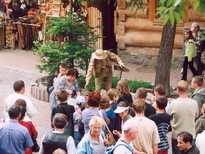
Mime artist in Zakopane
Košice
After a delicious breakfast and some deliberation with Harrie we left for the town of Košice, not far from Medzev. It was a bit difficult to
find the centre of the town, the road signs as well as our map were not very clear on this point. After some driving around we arrived at a place we'd
seen before and we decided to park the car and walk from there. It turned out we indeed were in the centre of town. The Hlavná is a completely
restored street which has most of the tourist sights of the second largest town of Slovakia. First we entered the St. Elizabeth's Cathedral, a very
beautiful gothic cathedral which is also being restored. It is very beautiful on the inside. After a short visit to the cathedral we continued our walk through
the main street of Košice. Today is Sunday and it is very quiet in town. Not many people in the streets, the shops are closed, even the Tourist Info
booth was closed. The façades of the buildings in the street, they are all very magnificent. At a bar we had something to drink, two coffees and some
lemonade for Ciska and three pieces of cake. This all for a total of 100 SKK, which equals 2.50 euro. After that we did some more walking before we took a rest near
the water organ, a large fountain in front of the theatre which spouts in the rhythm of music. For the local youth it is a challenge to walk into the fountain
and to try to stay dry. Which of course is not possible and everybody enjoys it to them getting their clothes wet. In a booklet we borrowed from Harrie there was
a Children's Railway mentioned (Čermel Valley Railway). That we tried to find, which was not easy as the Tourist Info was closed. Finally we succeeded to find the train just north-west of the
town. We arrived at the small station at around a quarter to three and the train didn't leave as early as 16:05. So in the meantime we has something to drink
at a nearby booth. Around a quarter to four we walked again to the station. The train now already was at the station and people were already boarding. At exactly
16:05 the small steam train left for the short 15 minutes ride. For this we had to pay 26 SKK (€ 0,65). At the terminus at Alpinka we got off the train. There you can find
a large playground with a restaurant. We first had the plan to eat something at the restaurant and then return. But we decided to take the next train back and
drive with our car to the restaurant so we had better planning of when to get back instead of being bound to the train schedule. So we went back with the train and
back at the beginning we took our car for a very short drive to the restaurant. Ciska there enjoyed herself very much in the playground while we had something
to drink in the shade. When the bar closed we walked to the nearby restaurant for dinner before we headed back to our apartment.
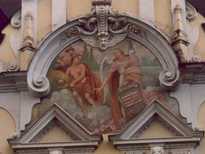
Painting on a façade in Košice
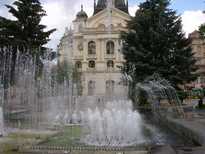
Fountain in front of the theatre in Košice

The local youth gets wet in the fountain

Ciska in the Children's Railway near Košice
Spišský Hrad
When in Slovakia, a visit to Spišský Hrad can not be missed. Spišský Hrad is the largest castle ruin of its kind in Europe. Via small winding
roads we drove in just under two hours to the castle. On the way Ciska complained about stomachache and just after that she said she had to vomit. For this we always
have a special vomit-towel with us (experience) and at the first possible place we stopped. At the moment we dragged het from the car she started vomiting, luckily
everything ended up in the towel and not directly in the car. When she felt a little better we continued. When we arrived at the parking place of the castle she had
to vomit again. When all was dome we had to do a steep climb to arrive at the castle itself. It took us about 20 to 30 minutes to climb up there. It is an extremely large
and impressive castle ruin, the original castle burned down in 1720. We walked around there for a few hours (it is really that big) to see the whole castle and the
accompanying museum. When we were ready with our visit we had something to eat before returning to our apartment via Presov and Košice. This is all highway and
not small winding roads to prevent Ciska from vomiting again. We also wanted to visit the caves in Jasov, near Medzev, but they were already closed so we returned
back to Vyšný Medzev as there would be a camp-fire with dinner at six. In the evening we had a camp-fire with sauerkraut soup, prepared by Jana, a Slovak
speciality, amongst other Slovak dishes. While we were having dinner it started to rain so we all went to the brand new covered terrace where we had a really nice companionable
evening with Harrie, Jana and the other guests.

The impressive castle ruin of Spišský Hrad
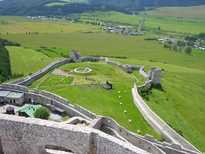
View on the surroundings from Spišský Hrad
Caves, caves and more caves ... and a monastery
When you are in this area of Slovakia you have to visit the Slovak Paradise and the Dobšiná ice cave. The next day, the weather looked very promising for a
nice walk in the Slovak Paradise. So we left early and around 10 o'clock we arrived at the parking place of the Dobšiná ice cave. The sky, by the way, looked
much more threatening than when we left Vyšný Medzev this morning. From the parking place it is long walk to the entrance of the cave. You have to climb a steep
hill. It turned out we have to climb a total of 160 metres to a height of 969 metres above sea level. When we were almost there, it started to rain and before we reached the
entrance it really poured down. There were a lot of visitors and not everybody was able to find a dry place under the roof of the cave info centre. At eleven a group entered
the cave, we had to wait for the next group. But fortunately some time later they allowed another large group to enter the cave, probably because of the rain. Normally only one
small group per hour is allowed to enter the cave. Inside, the cave is a beauty. There are large ice fields and large columns of ice. Only the temperature inside the cave is
rather cold, just below freezing-point. The only disadvantage was our guide, he only explained in Slovak. One of the advantages of the large was the fact that Arjan could
use its camcorder. Normally you have to pay 300 SKK to be allowed to use one and that was a bit too expensive. But because of the large group the guide was not able to check
it all. The tour takes about half an hour, luckily the raining had stopped when we leaved the cave and we stayed dry when walking down. Back down again we had something to eat
and drink in a restaurant before we left. As the weather didn't invite us for a nice walk in the Slovak Paradise we had to think of something else to do. Near the restaurant
was a large sign about the aragonite cave of Ochtiná. So again a good thing to visit on a rainy day. At 14:00 we arrived at the cave, not far from Dobšiná.
There we had to wait for one hour for the next tour into the cave. While waiting we had something to drink in the hall of the information centre and we read some information
about the cave. In the entire world there are only three known of these aragonite caved, so it really is a rarity.
At 15:00 we entered the cave, also now guided by a guide who only explained in Slovak. It's clear that in Slovakia tourism is still not very internationally
oriented. But who needs words when in a beautiful cave like this one, it is almost impossible to explain what an aragonite cave looks like. Everywhere on the ceiling, the
walls and in holes there are a kind of white cobwebs and things that looks like a sea-anemone or coral. And sometimes it looks like mould. Another time they are whimsical
prickles that hang from ceiling and look likes flowers, it is really beyond any description. This is something you have to see with your own eyes. Also in this cave the whole
tour lasts for about half an hour and around four pm we left. As we had no plans for the rest of the day we just drove around. At one moment it was dry and sometimes later
the rain poured down, sometimes even with some thunder. Around six we arrived in Rožňava where had an extensive dinner for the total amount of 716 SKK (18 euro).
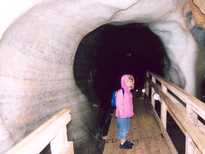
Ciska in a tunnel of ice in the Dobšiná icecave
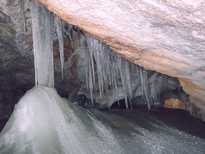
Enormous columns of ice and icicles
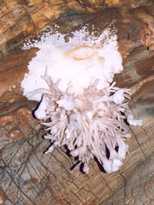
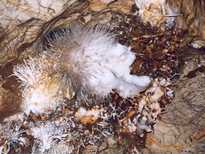
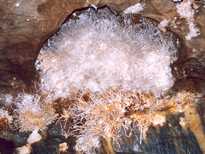
Unreal formations in the Ochtiná aragonite cave
The next day we went to Jasov, about 7 kilometres from Vyšný Medzev, to visit the monastery and, again, a cave. First we went to the monastery, the largest
monastery in all of Slovakia. Unfortunately only the church can be visited. All other parts of the monastery, including the garden, are closed to the public. In the church,
dedicated to John the Baptist, a lady gave us a private tour and she told us everything about the splendid interior what tells about the life, from birth to death, of
John the Baptist. Unfortunately we were not allowed to take pictures or video inside the church. From the monastery we went to the stalactitic cave of Jasov. Good choice as it
again looked like as it was going to rain. This is the third cave in two days. Again we had a guide that only explained in Slovak. The cave, like all stalactitic caves, has many
stalactites and stalagmites. Also several, smaller, halls where one can see all kind of shapes and figures in the sinter. These caves were already used in the 15th century as a
hiding place during the Hussite wars. These people wrote their names on the walls of the caves and they tell about the victory of Jan Jiskra over the armies of Jan Hunyadu
near Lucenec in February 1452. After the one-hour visit to the cave we had lunch in the nearby restaurant.

The beautiful church of the monastery in Jasov

Whimsical shapes in the stalactitic cave of Jasov

Another picture of the Jasov cave
Zádielska Dolina
After lunch we drove to a place called Zádiel where we did a walk in the Zádielska Dolina, the gap of Zádiel. Luckily the sky had cleared up, no more traces of
rain or dark clouds. We made a magnificent walk through the 3.5 km long gap, between high rising rock-faces and along a lovely murmuring brook, to a restaurant. This restaurant
is a typical example of departed glory from the Soviet Bloc era. A concrete box without windows and a few steel doors, it didn't look very inviting. It was closed so we ate our apples on one
of the benches that stood outside. Some time later it turned out that someone was present in the box and we bought something to eat and drink. Following a short rest, Arjan and Ciska
decided to climb up the rocks. Hilleke stayed below as it was a rather strenuous climb and she still suffered from the blisters she contracted during the climbs of the previous days.
After a strenuous climb of about half an hour, Arjan and Ciska arrived at the top of the rock. Along the way, Ciska had to take a few rests, but the climb was definitely an achievement
for a five-year old girl. Once above, we had a magnificent view over the surroundings and as the sky was clear we could see very far, way into Hungary. After about a quarter of
resting and enjoying the view we went back down which went much faster. In the meantime, Hilleke had enjoyed the beautiful weather and the squirrels in the wood. Back down again we had to
walk another 3.5 km back to the car. Along the way we heard a moped or something like that coming our way. But before we could see it, we heard a loud crash and then nothing.
A moment later we saw two men climbing from the verge. When we arrived there we saw that they had driven from the slope with their old Jawa motor-cycle and had ended up in the
shrubs, two metres below the road surface. In Slovak they asked Arjan if he could help them to get the motor-cycle back on the road. In the meantime Hilleke and Ciska could take
care of the rabbit they carried in a shopping-bag. They were afraid that it might escape otherwise; the rabbit was probably their dinner. After some troubles Arjan and the two men
succeeded in pushing the motor-cycle back onto the road. One of the men was still searching for some tools he had carried in his jacket and were fallen in the mud after the crash,
a number of spanners, screw-drivers and a spare spark-plug for the engine. Back on the road they were able to start the engine, but it didn't have any power. As soon as they released the
clutch, the engine stopped. After thanking us (we presume, it was in Slovak) and Ciska petting the rabbit we continued to our car. Back at the car we then drove to a roadside restaurant
to have some fish. Unfortunately not so good as the one we had in Poland. The restaurant also looked rather old and not very inviting but we didn't want to find another one.
After eating a very expensive fish (more than 900 SKK) we went back to our apartment.
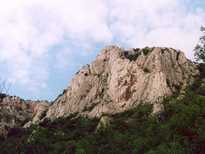
High rising rock alongside the gap
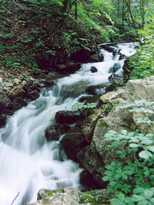
Lovely murmuring brook along the road through the gap
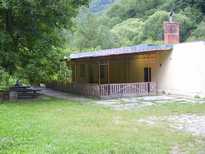
The 'cosy', Soviet Bloc era, restaurant

View over the surroundings from the rocks after a strenuous climb